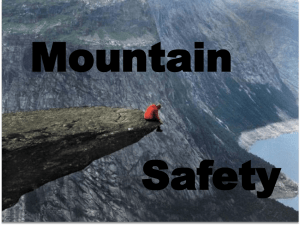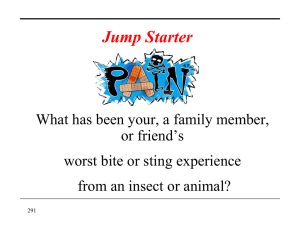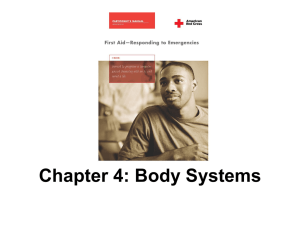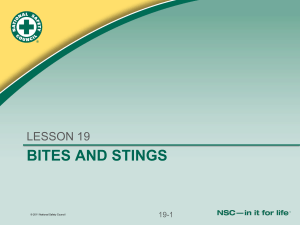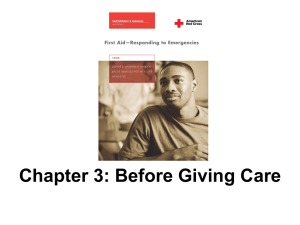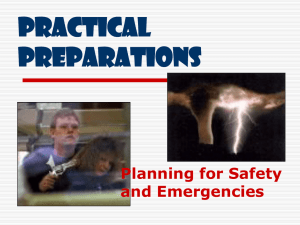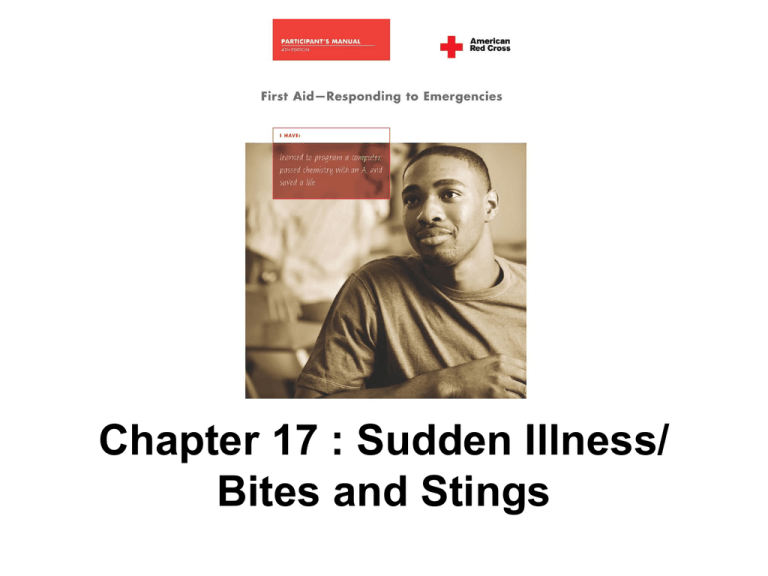
Chapter 17 : Sudden Illness/
Bites and Stings
Introduction
Bites and stings are among the most common forms of injected
poisonings.
Some of the most common types of bites and stings are from—
Insects.
Ticks.
Spiders and scorpions.
Marine life.
Snakes.
Domestic and wild animals.
Humans.
292
AMERICAN RED CROSS FIRST AID–RESPONDING TO EMERGENCIES FOURTH EDITION
Copyright © 2005, revised edition 2007, by The American National Red Cross
All rights reserved.
Signals of Common Bites and Stings
Specific signals of common bites and stings depend on—
The type and location of the bite or sting.
The amount of poison injected.
The time elapsed since the poisoning.
The victim’s size, weight, medical condition and age.
293
AMERICAN RED CROSS FIRST AID–RESPONDING TO EMERGENCIES FOURTH EDITION
Copyright © 2005, revised edition 2007, by The American National Red Cross
All rights reserved.
Signals of Common Bites and Stings
(continued)
Less severe reactions to bites and stings may trigger
signals including:
A bite or sting mark.
A stinger, tentacle or venom sac.
Redness.
Swelling.
Pain or tenderness.
Severe allergic reactions to bites and stings may bring on
a life-threatening condition anaphylaxis.
294
AMERICAN RED CROSS FIRST AID–RESPONDING TO EMERGENCIES FOURTH EDITION
Copyright © 2005, revised edition 2007, by The American National Red Cross
All rights reserved.
Insects
Between 0.5 to 5 percent of Americans are severely allergic to
substances in the venom of bees, wasps, hornets and yellow
jackets.
When a highly allergic person is stung, call 9-1-1 or the local
emergency number immediately for medical care.
For most people, insect stings may be painful or uncomfortable
but are not life threatening.
295
AMERICAN RED CROSS FIRST AID–RESPONDING TO EMERGENCIES FOURTH EDITION
Copyright © 2005, revised edition 2007, by The American National Red Cross
All rights reserved.
Care for Insect Stings
To give care for an insect sting—
Examine the sting site.
If the stinger is still present, remove it to prevent any further
poisoning.
Wash the area with soap and water and cover the site, then
apply ice or a cold pack.
Observe the victim for signals of allergic reaction.
296
AMERICAN RED CROSS FIRST AID–RESPONDING TO EMERGENCIES FOURTH EDITION
Copyright © 2005, revised edition 2007, by The American National Red Cross
All rights reserved.
Ticks
Ticks can contract, carry and transmit disease to humans.
Rocky Mountain spotted fever is caused by the transmission of
microscopic bacteria from the wood tick or dog tick host to
other warm-blooded animals.
The main signal of Rocky Mountain spotted fever is a
spotted rash.
Other signals of Rocky Mountain spotted fever include—
Fever.
Chills.
Severe headache.
Joint and muscle aches.
297
AMERICAN RED CROSS FIRST AID–RESPONDING TO EMERGENCIES FOURTH EDITION
Copyright © 2005, revised edition 2007, by The American National Red Cross
All rights reserved.
Ticks
(continued)
Lyme disease, or Lyme borreliosis, is another illness that
people can get from the bite of an infected tick.
The first signal of Lyme disease is a rash.
Other signals of Lyme disease include—
Fever and chills.
Headache.
Weakness or fatigue.
Flu-like joint and muscle aches.
298
AMERICAN RED CROSS FIRST AID–RESPONDING TO EMERGENCIES FOURTH EDITION
Copyright © 2005, revised edition 2007, by The American National Red Cross
All rights reserved.
Ticks
(continued)
In advanced stages, Lyme disease may cause—
Arthritis.
Numbness.
Memory loss.
Vision or hearing problems.
High fever.
Stiffness in the neck.
299
AMERICAN RED CROSS FIRST AID–RESPONDING TO EMERGENCIES FOURTH EDITION
Copyright © 2005, revised edition 2007, by The American National Red Cross
All rights reserved.
Protection from Tick Bites
To protect yourself from tick bites—
Wear repellent and proper clothing.
Check and clean your clothes thoroughly after having been
in wooded areas.
Use precautions when removing a tick.
300
AMERICAN RED CROSS FIRST AID–RESPONDING TO EMERGENCIES FOURTH EDITION
Copyright © 2005, revised edition 2007, by The American National Red Cross
All rights reserved.
Care for Tick Bites
Remove the embedded tick.
Do not try to burn the tick off.
Do not apply petroleum jelly or nail polish to the tick.
Place the tick in a sealable container for analysis.
If you cannot remove the tick or parts remain, get medical care.
Wash the bite area with soap and water.
Apply antiseptic or triple antibiotic ointment.
Wash your hands.
301
AMERICAN RED CROSS FIRST AID–RESPONDING TO EMERGENCIES FOURTH EDITION
Copyright © 2005, revised edition 2007, by The American National Red Cross
All rights reserved.
Spider Bites
Few spiders in the United States have venom that can cause
death.
Two spiders that can cause illness and occasionally death are
the—
Black widow spider.
Brown recluse spider.
Bites usually occur on the hands or arms.
302
AMERICAN RED CROSS FIRST AID–RESPONDING TO EMERGENCIES FOURTH EDITION
Copyright © 2005, revised edition 2007, by The American National Red Cross
All rights reserved.
Spider Bites
(continued)
A black widow spider bite usually causes a sharp pinprick pain
followed by a dull pain in the area of the bite.
Other signals of this spider bite include—
Muscular rigidity.
Restlessness.
Anxiety.
Profuse sweating.
Weakness.
Drooping eyelids.
303
AMERICAN RED CROSS FIRST AID–RESPONDING TO EMERGENCIES FOURTH EDITION
Copyright © 2005, revised edition 2007, by The American National Red Cross
All rights reserved.
Scorpion Stings
Scorpions live in dry regions of the southwestern United States
and Mexico and are most active at night, which is when most
stings occur.
Since it is hard to distinguish poisonous scorpions from the nonpoisonous scorpions, all scorpion stings should be treated as
medical emergencies.
304
AMERICAN RED CROSS FIRST AID–RESPONDING TO EMERGENCIES FOURTH EDITION
Copyright © 2005, revised edition 2007, by The American National Red Cross
All rights reserved.
Signals of Spider Bites and Scorpion Stings
Signals of spider bites and scorpion stings may include—
A mark indicating a possible bite or sting.
Severe pain in the area of the bite or sting.
A blister, lesion or swelling at the entry or bite site.
Nausea and vomiting.
Trouble breathing or swallowing.
Sweating or salivating profusely.
Irregular heart rhythm.
Muscle cramping or abdominal pain.
305
AMERICAN RED CROSS FIRST AID–RESPONDING TO EMERGENCIES FOURTH EDITION
Copyright © 2005, revised edition 2007, by The American National Red Cross
All rights reserved.
Care for Spider Bites and Scorpion Stings
If a person is bitten by a spider (i.e., brown recluse or black
widow) or stung by a scorpion—
Call 9-1-1 or the local emergency number immediately.
Wash the wound.
Apply ice or a cold pack.
306
AMERICAN RED CROSS FIRST AID–RESPONDING TO EMERGENCIES FOURTH EDITION
Copyright © 2005, revised edition 2007, by The American National Red Cross
All rights reserved.
Snakes
Medical personnel are not in general agreement about care for
snakebites.
Most deaths from snakebites occur because—
The victim has an allergic reaction.
The victim is in poor health.
Too much time passes before the victim receives medical care.
Signals that indicate a poisonous snakebite include—
One or two distinct puncture wounds.
Severe pain and burning at the wound site.
Swelling and discoloration at the wound site.
307
AMERICAN RED CROSS FIRST AID–RESPONDING TO EMERGENCIES FOURTH EDITION
Copyright © 2005, revised edition 2007, by The American National Red Cross
All rights reserved.
Care for Snakebites
Follow these guidelines to care for someone bitten by a snake:
Call 9-1-1 or the local emergency number.
Wash the wound.
Immobilize the affected part.
Keep the affected area lower than the heart, if possible.
Minimize the victim’s movement.
If the bite is from an elapid snake such as a coral snake:
• Apply an elastic roller bandage.
• Use overlapping turns, gently stretching the bandage as you wrap.
• Begin at the point furthest from the heart.
• Check for circulation of the limb beyond the point where bandaging
begins. (Note changes in skin color and temperature.)
308
AMERICAN RED CROSS FIRST AID–RESPONDING TO EMERGENCIES FOURTH EDITION
Copyright © 2005, revised edition 2007, by The American National Red Cross
All rights reserved.
Care for Snakebites
(continued)
Regardless of what you may have otherwise heard or read—
Do not apply ice.
Do not cut the wound.
Do not apply suction.
Do not apply a tourniquet.
Do not use electric shock.
309
AMERICAN RED CROSS FIRST AID–RESPONDING TO EMERGENCIES FOURTH EDITION
Copyright © 2005, revised edition 2007, by The American National Red Cross
All rights reserved.
Marine Life
Some marine life, such as jellyfish, can inflict painful injuries
that can make you sick.
The side effects of marine life stings include allergic reactions
that can cause—
Trouble breathing.
Heart problems.
Paralysis.
310
AMERICAN RED CROSS FIRST AID–RESPONDING TO EMERGENCIES FOURTH EDITION
Copyright © 2005, revised edition 2007, by The American National Red Cross
All rights reserved.
Care for Marine Life Stings
Remove the victim from the water.
Call 9-1-1 or the local emergency number if the victim—
Does not know what stung him or her.
Has a history of allergic reactions to marine life stings.
Is stung on the face or neck.
Develops trouble breathing.
311
AMERICAN RED CROSS FIRST AID–RESPONDING TO EMERGENCIES FOURTH EDITION
Copyright © 2005, revised edition 2007, by The American National Red Cross
All rights reserved.
Care for Marine Life Stings
For jellyfish, sea anemone or Portuguese man-of-war stings—
Soak the injured part in vinegar.
Do not apply fresh water or ammonia.
Do not rub the area.
For stingray, sea urchin or spiny fish stings—
Flush the wound with tap water or ocean water.
Immobilize the injured part.
Soak the body part in hot water.
Clean the wound.
Bandage the wound.
312
AMERICAN RED CROSS FIRST AID–RESPONDING TO EMERGENCIES FOURTH EDITION
Copyright © 2005, revised edition 2007, by The American National Red Cross
All rights reserved.
Domestic and Wild Animals
The bite of a domestic or wild animal, like a human bite,
carries the risk of infection as well as soft tissue injury.
One of the most serious diseases that can result from a wild or
domestic animal bite is rabies.
Rabies is fatal if not treated. Professional medical attention is
needed as soon as possible.
Tetanus is a potentially fatal infection that affects the central
nervous system.
It is caused by the transmission of bacteria that produce a
toxin when someone is bitten by an animal or human.
313
AMERICAN RED CROSS FIRST AID–RESPONDING TO EMERGENCIES FOURTH EDITION
Copyright © 2005, revised edition 2007, by The American National Red Cross
All rights reserved.
Domestic and Wild Animals
(continued)
Signals of tetanus include—
Irritability.
Headache.
Fever.
Painful muscular spasms.
One of the most common signals of tetanus is muscular
stiffness in the jaw, which is why tetanus is sometimes
known as “lockjaw.”
314
AMERICAN RED CROSS FIRST AID–RESPONDING TO EMERGENCIES FOURTH EDITION
Copyright © 2005, revised edition 2007, by The American National Red Cross
All rights reserved.
Care for Domestic and Wild Animal Bites
If someone is bitten by an animal, try to get the person safely
away from the animal.
For a minor wound—
Wash the wound with soap and water.
Control bleeding.
Apply triple antibiotic ointment.
Apply a dressing.
Monitor for signals of infection.
315
AMERICAN RED CROSS FIRST AID–RESPONDING TO EMERGENCIES FOURTH EDITION
Copyright © 2005, revised edition 2007, by The American National Red Cross
All rights reserved.
Care for Domestic and Wild Animal Bites
(continued)
If the wound is bleeding heavily—
Control the bleeding, but do not clean the wound.
Call 9-1-1 or the local emergency number.
Contact animal control authorities, if possible and if
necessary.
316
AMERICAN RED CROSS FIRST AID–RESPONDING TO EMERGENCIES FOURTH EDITION
Copyright © 2005, revised edition 2007, by The American National Red Cross
All rights reserved.
Human Bites
Human bites differ from other bites because they may be
more contaminated, tend to occur in higher-risk areas of
the body and often receive delayed care.
Human saliva has been found to contain at least 42
different kinds of species of bacteria.
According to the CDC, human bites are not considered to
carry a risk of transmitting hepatitis B or HIV.
317
AMERICAN RED CROSS FIRST AID–RESPONDING TO EMERGENCIES FOURTH EDITION
Copyright © 2005, revised edition 2007, by The American National Red Cross
All rights reserved.
Care for Human Bites
If the wound is not severe:
Wash the wound thoroughly with soap and water.
Control the bleeding.
Apply a dressing.
Take the victim to a physician or medical facility.
If the bite is severe:
Control the bleeding.
Call 9-1-1 or the local emergency number.
318
AMERICAN RED CROSS FIRST AID–RESPONDING TO EMERGENCIES FOURTH EDITION
Copyright © 2005, revised edition 2007, by The American National Red Cross
All rights reserved.
Preventing Bites and Stings
Preventing bites and stings from insects, spiders, ticks,
snakes, scorpions and marine life is the best protection
against the transmission of injected poisons.
319
AMERICAN RED CROSS FIRST AID–RESPONDING TO EMERGENCIES FOURTH EDITION
Copyright © 2005, revised edition 2007, by The American National Red Cross
All rights reserved.
Preventing Bites and Stings
(continued)
Follow these general guidelines to prevent bites and stings:
Apply repellent.
Wear sturdy boots.
Wear long-sleeved shirts and long pants.
Tuck pant legs into socks or boots and tuck shirt into pants.
Wear light-colored clothing.
Use a rubber band or tape where pants and socks meet to
prevent ticks or insects from getting under clothing.
Inspect yourself carefully after being outdoors.
320
AMERICAN RED CROSS FIRST AID–RESPONDING TO EMERGENCIES FOURTH EDITION
Copyright © 2005, revised edition 2007, by The American National Red Cross
All rights reserved.
Preventing Bites and Stings
(continued)
Shower immediately after coming indoors.
Keep an eye out for and avoid nests.
Spray pets that go outdoors with repellent.
Stay in the middle of trails when hiking.
Avoid walking in areas known to be populated
with snakes.
Make noise as you walk.
If you encounter a snake, walk away on the same
path you were on.
321
AMERICAN RED CROSS FIRST AID–RESPONDING TO EMERGENCIES FOURTH EDITION
Copyright © 2005, revised edition 2007, by The American National Red Cross
All rights reserved.
Preventing Bites and Stings
(continued)
To prevent stings from marine animals, you might consider
wearing a wetsuit or drysuit or protective footwear in the
water.
To prevent dog bites—
Do not run past a dog.
Avoid eye contact, try to remain motionless.
Do not approach a strange dog.
Always let a dog see and sniff you before you pet the
animal.
322
AMERICAN RED CROSS FIRST AID–RESPONDING TO EMERGENCIES FOURTH EDITION
Copyright © 2005, revised edition 2007, by The American National Red Cross
All rights reserved.
Closing
Learning how to recognize, care for and prevent some of the
most common types of bites and stings can help you give care
to a victim.
For suspected injected poisonings, call the National Poison
Control Center, 9-1-1 or the local emergency number if the
victim shows life-threatening conditions.
The best way to avoid any kind of poisoning is to take steps to
prevent it.
Questions?
323
AMERICAN RED CROSS FIRST AID–RESPONDING TO EMERGENCIES FOURTH EDITION
Copyright © 2005, revised edition 2007, by The American National Red Cross
All rights reserved.

